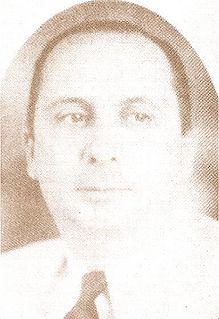 W
WThe Republic of Cuba from 1902 to 1959 encompasses the period after Cuba's independence from the Spanish Empire and end of its first U.S. military occupation in 1902. This era included various changing governments and US military occupations, and ended with the success of the Cuban Revolution in 1959. During this period, the United States exerted great influence on Cuban politics, notably through the Platt Amendment.
 W
WFulgencio Batista y Zaldívar was a Cuban military officer and politician who served as the elected President of Cuba from 1940 to 1944 and as its U.S.-backed military dictator from 1952 to 1959, before being overthrown during the Cuban Revolution. Batista initially rose to power as part of the 1933 Revolt of the Sergeants, which overthrew the provisional government of Carlos Manuel de Céspedes y Quesada. He then appointed himself chief of the armed forces, with the rank of colonel and effectively controlled the five-member "pentarchy" that functioned as the collective head of state. He maintained this control through a string of puppet presidents until 1940, when he was himself elected President of Cuba on a populist platform. He then instated the 1940 Constitution of Cuba and served until 1944. After finishing his term, Batista moved to Florida, returning to Cuba to run for president in 1952. Facing certain electoral defeat, he led a military coup against President Carlos Prío Socarrás that pre-empted the election.
 W
WBlas Roca Calderio was a Cuban politician and Marxist theorist who served as President of the National Assembly of People's Power in Cuba from 1976 to 1981. He was also head of the pre-1959 revolution Communist Party of Cuba for 28 years and editor of the communist newspaper Hoy. He was a signatory of the Cuban Constitution of 1940 and chaired the committee that wrote the country's first socialist constitution in 1976.
 W
WGustavo Cuervo Rubio, he was a Cuban doctor and politician.
 W
WDr. Ramón Grau San Martín was a Cuban physician and President of Cuba. He was the last president other than an interim president, Carlos Manuel Piedra, to be born during Spanish rule. He is sometimes called Raymond Grau San Martin in English.
 W
WFélix Lancís Sánchez was a Cuban politician and Prime Minister of Cuba.
 W
WDr. Federico Laredo Brú was an attorney and served as President of Cuba from 1936 to 1940. He was married to Leonor Gomez-Montes (1880-?).
 W
WCarlos Saladrigas Zayas was a Cuban politician and diplomat.
 W
WManuel Antonio de Varona y Loredo was a Cuban lawyer and politician.
 W
WThe history of Cuba during World War II begins in 1939. Because of Cuba's geographical position at the entrance of the Gulf of Mexico, Havana's role as the principal trading port in the West Indies, and the country's natural resources, Cuba was an important participant in the American Theater of World War II, and it was one of the greatest beneficiaries of the United States' Lend-Lease program. Cuba declared war on the Axis powers in December 1941, making it one of the first Latin American countries to enter the conflict. When the war ended in 1945, the Cuban military had developed a reputation of being the most efficient and co-operative Caribbean nation.
 W
WRamón Zaydín y Márquez Sterling (1895–1968) was a Cuban politician and Prime Minister of Cuba.